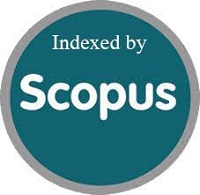Technostress Construct Validity Test with Confirmatory Factor Analysis (CFA) Method
DOI:
https://doi.org/10.15408/jp3i.v13i1.31423Keywords:
confirmatory factor analysis, teaching staff, technostress.Abstract
This study aims to test the construct validity of the technostress instrument using an instrument developed by Ragu-Nathan et al. (2008) contained 20 modified items using the Indonesian language. The research data was obtained from middle adult teaching staff, namely teachers and lecturers aged 35-60 who taught online learning during Covid-19. 212 respondents participated in this study. The test used confirmatory factor analysis (CFA) with first-order per-dimensional, first-order unidimensional, and second-order models. The analysis was done in MPLUS. Based on CFA first-order unidimensional results, the model fits the data with one item discarded (Item 17). The CFA second-order model is also fit according to the goodness criteria with all items being valid except item 6. According to CFA first-order per-dimensional testing, results show that items for three dimensions (techno-overload, techno-complexity, and techno-insecurity) are valid, while the other two dimensions (techno-uncertainty and techno-invasion) are not fit because the number of items is too small. The instrument can be used to measure technostress and is considered to be unidimensional measuring technostress.
References
Ayyagari, R., Grover, V., & Purvis, R. (2011). Technostress: Technological antecedents and implications. MIS Quarterly: Management Information Systems, 35(4), 831–858. https://doi.org/10.2307/41409963
Chiappetta, M. (2017). The Technostress: Definition, symptoms and risk prevention. Senses and Sciences, 4(1), Article 1. https://sensesandsciences.com/index.php/Senses/article/view/109
Çoklar, A. N., Efíltí, E., & Şahín, Y. L. (2017). Defining teachers’ technostress levels: A scale development. Journal of Education and Practice, 8(21), 28–41.
De Carlo, A., Girardi, D., Dal Corso, L., Arcucci, E., & Falco, A. (2022). Out of Sight, Out of Mind? A Longitudinal Investigation of Smart Working and Burnout in the Context of the Job Demands–Resources Model during the COVID-19 Pandemic. Sustainability, 14(12), 7121. https://doi.org/10.3390/su14127121
Distefano, C., Zhu, M., & Mîndrilã, D. (2009). Understanding and Using Factor Scores: Considerations for the Applied Researcher. https://doi.org/10.7275/DA8T-4G52
Fahdiansyah, R., & Anas, A. S. (2017). Teknologi Informasi sebagai Penunjang Perkembangan Sistem Informasi dalam Akuntansi. Simposium Nasional Teknologi Terapan (SNTT), 5(November), 246–253.
Hendartono, A. (2022). Model Hubungan Technostress Terhadap Emotional Exhaustion Pada Mahasiswa Perguruan Tinggi Maritim Selama Pembelajaran Online. Jurnal Saintek Maritim, 23(1), 3.
Jeske, D., & Axtell, C. (2014). e-Internships: Prevalence, characteristics and role of student perspectives. Internet Research, 24(4), 457–473. https://doi.org/10.1108/IntR-11-2012-0226
Ki, F. Y. C., & Chow, S.-C. (1995). Statistical Justification for the Use of Composite Scores in Quality of Life Assessment. Drug Information Journal, 29(2), 715–727. https://doi.org/10.1177/009286159502900251
Nimrod, G. (2018). Technostress: Measuring a new threat to well-being in later life. Aging and Mental Health, 22(8), 1080–1087. https://doi.org/10.1080/13607863.2017.1334037
Nudurupati, S. S., Bititci, U. S., Kumar, V., & Chan, F. T. S. (2011). State of the art literature review on performance measurement. Computers and Industrial Engineering, 60(2), 279–290. https://doi.org/10.1016/j.cie.2010.11.010
Ragu-Nathan, T. S., Tarafdar, M., Ragu-Nathan, B. S., & Tu, Q. (2008). The consequences of technostress for end users in organizations: Conceptual development and validation. Information Systems Research, 19(4), 417–433. https://doi.org/10.1287/isre.1070.0165
Rahmatullah, A. S., Mulyasa, E., Syahrani, S., Pongpalilu, F., & Putri, R. E. (2022). Digital era 4.0: The Contribution to Education and Student Psychology. Linguistics and Culture Review, 6, 89–107. https://doi.org/10.21744/lingcure.v6ns3.2064
Setyadi, H. J., & Taruk, M. (2019). Analisis Dampak Penggunaan Teknologi (Technostress) Kepada Dosen dan Staff Karyawan Yang Berpengaruh Terhadap Kinerja di Dalam Organisasi (Studi Kasus: Perguruan Tinggi di Kalimantan Timur). Informatika Mulawarman : Jurnal Ilmiah Ilmu Komputer, 14(1), 1. https://doi.org/10.30872/jim.v14i1.1792
Stich, J. F., Tarafdar, M., & Cooper, C. L. (2018). Electronic communication in the workplace: Boon or bane? Journal of Organizational Effectiveness, 5(1), 98–106. https://doi.org/10.1108/JOEPP-05-2017-0046
Tarafdar, M., Pullins, E. B., & Ragu-Nathan, T. S. (2014). Examining impacts of technostress on the professional salesperson’s behavioural performance. Journal of Personal Selling and Sales Management, 34(1), 51–69. https://doi.org/10.1080/08853134.2013.870184
Tarafdar, M., Tu, Q., Ragu-Nathan, T. S., & Ragu-Nathan, B. S. (2011). Crossing to the dark side: Examining creators, outcomes, and inhibitors of technostress. Communications of the ACM, 54(9), 113–120. https://doi.org/10.1145/1995376.1995403
Thompson, B. (2004). Exploratory and Confirmatory Factor Analysis: Understanding Concepts and Applications. American Psychological Association.
Umar, J., & Nisa, Y. F. (2020). Uji validitas konstruk dengan CFA dan pelaporannya. Jurnal Pengukuran Psikologi Dan Pendidikan Indonesia, 9(2), 1–11.
Walz, K. (2012). Stress Related Issues Due to Too Much Technology: Effects on Working Professionals. MBA Student Scholarship., 12, 1–24.
Wells, R. D. (1999). Factor scores and factor structure and communality coefficients. Advances in Social Science Methodology, 5, 123–138.
Woodbury, M. A., & Lord, F. M. (1956). The Most Reliable Composite with A Specified True Score. British Journal of Statistical Psychology, 9(1), 21–28. https://doi.org/10.1111/j.2044-8317.1956.tb00165.x
Yusuf. (2021). Pandemi Covid-19 Pacu Adaptasi Gunakan Teknologi Digital. Kominfo.Com. https://www.kominfo.go.id/content/detail/32602/pandemi-covid-19-pacu-adaptasi-gunakan-teknologi-digital/0/berita_satker
Zhou, L., Li, F., Wu, S., & Zhou, M. (2020). “School’s Out, But Class’s On”, The Largest Online Education in the World Today: Taking China’s Practical Exploration During The COVID-19 Epidemic Prevention and Control as an Example. Best Evidence of Chinese Education, 4(2), 501–519. https://doi.org/10.15354/bece.20.ar023



